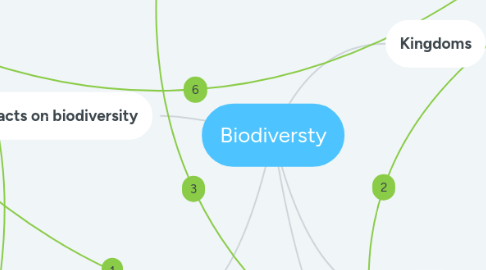
1. Science of classifying living things
2. Kingdoms
2.1. Animals
2.1.1. Multicellular eukaryotic orginisms that usually can move, are hetrothrophic, and has special sensory organs
2.2. Plants
2.2.1. A multicellular eukaryotic orginism that has cell walls containing cellulose, obtains energy through photosythesis, and is sessile
2.3. Protists
2.3.1. Unicellular eukaryotic orginisms, extremly diverse, three types, animal-like, plant-like, and fungi-like
2.4. Fungi
2.4.1. Multicellular eukaryotic orginisms, reproduce sexually and asexualy, are heterotrophs and form parasitic or symboitic relationships with other orginisms
2.5. Bacteria
2.5.1. Prokaryotic orginisms, live in moderate environments, has peptidoglycan and other specialized physical features
2.6. Archaea
2.6.1. Prokaryotic orginisms, live in extreme environments, does not have peptidoglycan
3. Human impacts on biodiversity
3.1. Habitat loss
3.1.1. Loss or distruction of an ecosystem's nurient reasources and/or soil, water, or plants
3.2. Invasive species
3.2.1. Non-native animails coming into an ecosystem and disrupting the natural balance
3.3. Pollution
3.3.1. Addition of harmful substances into a ecosystem
3.4. Climate change
3.4.1. Long term change to an ecosystem's climate
3.5. Overharvesting
3.5.1. Havesting too many resources from an ecosystem that leads to a decline in either habitat or orginisms
4. Classifaction
4.1. Taxonomy
4.1.1. Phylogentic trees
4.1.1.1. Diagram showing the evoultionary relationship between diffrent species
4.1.2. Dichomnomous keys
4.1.2.1. A tool that is used to identify a speices using a series of specific questions
